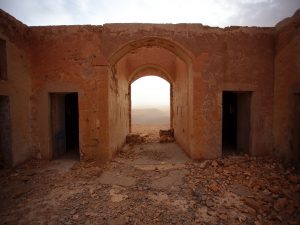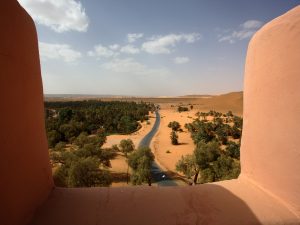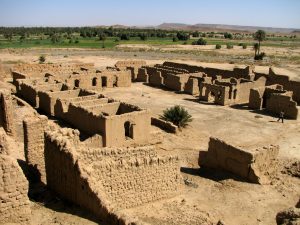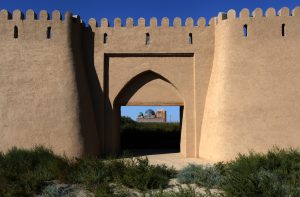 Dr Berny Sèbe
Dr Berny Sèbe
Senior Lecturer in Colonial and Post-Colonial Studies
Principal investigator of the ‘Outposts of Conquest’ project (www.birmingham.ac.uk/empires)
Empires of Emptiness: What the past tells us about desert warfare in the Sahara – at a time when it is being fought
When it comes to fighting jihadists in the desert, forget about the buzzwords now commonly associated with radical Islam elsewhere: social networks, internet recruitment or online propaganda. Of course, cybercafes are not entirely absent, even in the most remote oases, so cyber-recruitment and e-propaganda are not entirely irrelevant, but there are more important aspects to the picture to be taken into account when it comes to war in the desert.

The main courtyard of the fortress of Zirara, Algeria. Photo Yacine Ketfi.
At least, these are the preliminary conclusions of a research project I am leading at the University of Birmingham (in collaboration with Prof. Alexander Morrison, at Nazarbayev University, Kazakhstan), which examines strategies of colonial conquest and administration in arid environments, through the case-study of desert fortresses. Back in the nineteenth century, policy makers in London, Paris or Moscow faced questions and challenges which were not so dissimilar to those which are asked today when it comes to, let us say, Libya or Mali.
When French forces decided to renovate and expand in 2013 an old desert fortress in the barren sandy plains of Madama, in the far north-east of Niger, in an attempt to control human, trade and trafficking fluxes between the deeply unstable Southern Libya and the rest of the Saharo-Sahelian belt, they actually emulated what their predecessors had done a century before. The construction of fortified bases from which military power can be projected has been a regular feature of modern desert warfare, and even drones and supersonic fighter jets have not made this form of effective territorial control redundant.
The challenges any army trying to confront an ever-elusive enemy like jihadist fighters are reminiscent of those faced by nineteenth-century empire builders. How can vast and sparsely populated spaces be controlled effectively? How can potential allies be distinguished effectively from die-hard hostile forces? Which strategies will ensure that the arrival of a new player able to flex its muscles does not provide a massive recruitment boost to the opposing party? What is the most effective balance between mobility and brute sedentary force?

Views towards the palm grove from the fortress of Taghit, Algeria. Photo Yacine Ketfi.
This is where the past can teach present strategists a few lessons: not only in terms of where fortresses can be located effectively, but also how they are best used to enhance impact: as intelligence centres as much as logistical bases, and also as symbolic statements which foster local support. In a context where traditional values of sometimes violent masculinity prevail, airpower is often seen as a proof of weakness: it can only be chosen by those who seek to evade direct, virile confrontation. In the nineteenth century as much as today, fortresses assert a stern determination to act effectively on the ground, and guarantee and can generate further rallying.
Past experience also tells us that fortresses can only be effective if they are located at strategic places which cannot be easily avoided: they become more a statement of vanity if they can be easily bypassed. Tactful management of human relations is needed to ensure that they do not become the embodiment of a much-despised foreign presence. And crucially, they are effective only if they can operate as springboards from which military power is projected – with camel-mounted troops then, and all-terrain jeeps and lorries now.

The architectural structure of the Bordj of Erfoud East, Sahara. Photo Berny Sèbe.
More generally, the past tells us that the Sahara has its own socio-cultural dynamics based on centuries of subtle negotiations between various competing communities, and that this complex human fabric has to be understood if any form of durable settlement is to be found. Local susceptibilities are also best taken into account, to avoid antagonising those who have to be seen as partners rather than obstacles. This is the reason why collateral damage is all the more significant in such societies which have long-term memories. The way in which Sahara nomads in general have also tolerated or even supported the French presence after having resisted it in the first place, can also teach us a lot when it comes to devising strategies for long-term peace and stability in the region: local population need to be clearly the net beneficiaries of the return of peace, and take an active part in it. The Pax Gallica worked in the first half of the twentieth century because it was locally co-opted and offered prized rewards. In the twenty-first century, jihadist movements
Anyone reading Winston Churchill’s observations about the Afghans in his debut book The Story of the Malakand Field Force (1897) will be struck by how relevant some of his observations have remained. In spite of the staggering speed at which the world changes, it seems that the past can still teach us a lot, especially when looking at such specific environments like the Sahara or the Himalayas. It is probably not a coincidence if the French, who had the benefit of a century and a half of military operations in the Sahara, have been able, against all odds, to achieve in Northern Mali in less than a year what an international coalition led by the United States has been unable to get in Afghanistan in a decade.
The ‘Outposts of Conquest’ project (funded by the Arts and Humanities Research Council) has given rise to an exhibition which is being shown until 16 December 2016:
‘Empires of Emptiness – Fortresses of the Sahara and the Steppe’, in the Footprint Gallery at Jackfield Tile Museum, Ironbridge Gorge TF8 7LJ. Open everyday from 10am until 5pm. Admission is free of charge.

The walls of the fortress of Turkestan, built by the Khanate of Kokand. Photo Berny Sèbe
